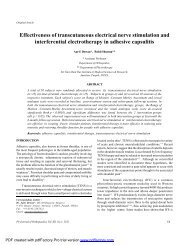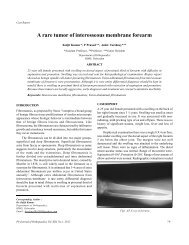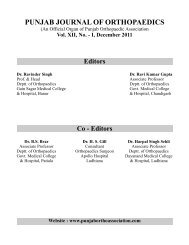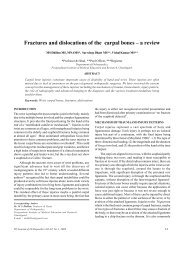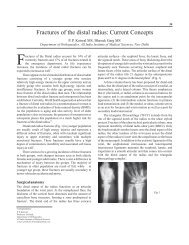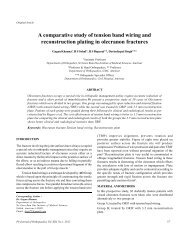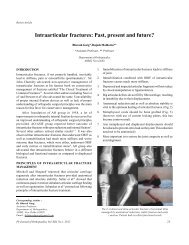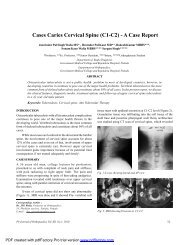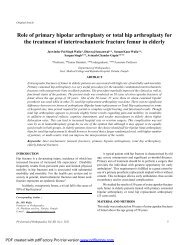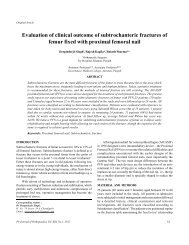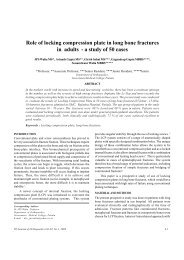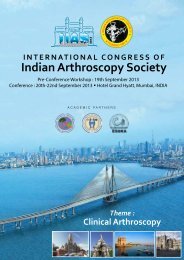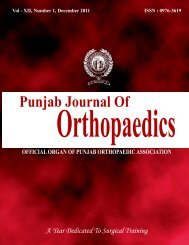Giant cell tumour of talus - Punjab Orthopaedic Association
Giant cell tumour of talus - Punjab Orthopaedic Association
Giant cell tumour of talus - Punjab Orthopaedic Association
Create successful ePaper yourself
Turn your PDF publications into a flip-book with our unique Google optimized e-Paper software.
Case Report<br />
<strong>Giant</strong> <strong>cell</strong> <strong>tumour</strong> <strong>of</strong> <strong>talus</strong>-<br />
A rare presentation & our management<br />
Murali SM*, Victor Moirangthem # , Mothilal SN**<br />
*Assistant Pr<strong>of</strong>essor, **Pr<strong>of</strong>essor & Head<br />
Department <strong>of</strong> <strong>Orthopaedic</strong>s<br />
Sri Satya Sai Medical College & Research Institute, Chennai<br />
#<br />
Assistant Pr<strong>of</strong>essor<br />
Department <strong>of</strong> <strong>Orthopaedic</strong>s,Chettinad Medical College, Chennai<br />
ABSTRACT<br />
<strong>Giant</strong> Cell Tumour <strong>of</strong> the small bones <strong>of</strong> the hand and foot are relatively uncommon. We are reporting a case<br />
<strong>of</strong> <strong>Giant</strong> Cell Tumour <strong>of</strong> the <strong>talus</strong> in a 20 year old female patient. She presented with painful swelling <strong>of</strong> left<br />
ankle with a large osteolytic lesion in the <strong>talus</strong> on conventional radiographs. Due to the extensive nature <strong>of</strong><br />
the lesion, talectomy and fusion was done. Biopsy showed a grade 2 <strong>Giant</strong> Cell Tumour <strong>of</strong> bone. After 30<br />
months <strong>of</strong> follow-up,the <strong>tumour</strong> showed no signs <strong>of</strong> recurrence.<br />
Keywords: <strong>Giant</strong> <strong>cell</strong> <strong>tumour</strong>, Talus, Talectomy, Tibiocalcaneal fusion<br />
INTRODUCTION<br />
<strong>Giant</strong> Cell Tumour <strong>of</strong> the <strong>talus</strong> is extremely rare and so far<br />
only 14 cases are reported in the literature 1-3 . <strong>Giant</strong> Cell<br />
Tumour (GCT) is a locally aggressive neoplasm characterised<br />
by richly vascularised tissue containing proliferating<br />
mononuclear stromal <strong>cell</strong>s and many osteoclast-like<br />
multinucleated giant <strong>cell</strong>s randomly but evenly distributed<br />
throughout. The recurrence <strong>of</strong> <strong>tumour</strong> is fairly common with<br />
GCT’s and may metastasize in 3% <strong>of</strong> patients. Currently, the<br />
modalities <strong>of</strong> treatment for GCT include curettage and grafting,<br />
enbloc resection with grafting or arthrodesis, chemical cautery,<br />
talectomy and amputation 1,4 .<br />
CASE REPORT<br />
A 20 year old woman presented with pain in the left ankle for<br />
one year following trivial injury. It had gradually increased in<br />
intensity with the appearance <strong>of</strong> swelling around the ankle for<br />
the past 2 months. On examination, the swelling was diffuse<br />
obliterating the bony prominences, moderately tender and had<br />
mild local inflammation. Movements were limited in both the<br />
ankle and subtalar joints. Walking was difficult due to pain.<br />
Corresponding Author :<br />
Dr Murali SM,<br />
47 Oliver Road, Mylapore,<br />
Chennai-600004,India.<br />
Email : muraliorth@gmail.com<br />
Pb Journal <strong>of</strong> <strong>Orthopaedic</strong>s Vol-XIII, No.1, 2012<br />
There was no distal neurovascular deficit.<br />
Based on history and physical findings, our primary<br />
differential diagnosis were as follows: tubercular arthritis, <strong>Giant</strong><br />
Cell Tumour <strong>of</strong> bone and aneurysmal bone cyst. Except for a<br />
slightly raised erythrocyte sedimentation rate, routine<br />
laboratory testing was normal. Plain radiographs showed an<br />
osteolytic lesion involving the head, neck and body <strong>of</strong> the<br />
<strong>talus</strong> with partial collapse <strong>of</strong> the neck (Fig 1).<br />
The surrounding bony tissue had thinned out. The margins<br />
<strong>of</strong> subtalar and talonavicular joints showed mild sclerosis.<br />
AP View<br />
Lateral View<br />
Fig 1. Preoperative X ray-showing lytic lesions <strong>of</strong> head,<br />
neck, body <strong>of</strong> <strong>talus</strong>. Collapse <strong>of</strong> talar neck.<br />
89
Murali et al<br />
Fig 2. Preoperative CT scan- showing sclerosis <strong>of</strong><br />
talonavicular and subtalar joints<br />
Fig 4. Excised Tumour Tisssue- sent for HPE<br />
Fig 3. Intraoperative Picture- <strong>talus</strong> being exposed<br />
Her chest roentgenogram was negative for any pathological<br />
process <strong>of</strong> metastases. The NCCT <strong>of</strong> the foot and ankle revealed<br />
an aggressive GCT involving almost the whole <strong>of</strong> the <strong>talus</strong><br />
(Fig 2). There was no evidence <strong>of</strong> joint disruption or spread to<br />
any <strong>of</strong> the adjacent bones.<br />
Because <strong>of</strong> the aggressive nature <strong>of</strong> the lesion and<br />
radiological evidence <strong>of</strong> early degenerative changes, it was<br />
suggested that a more substantial surgery than simple<br />
curettage and bone grafting would be necessary (Fig 3 &4).<br />
With these factors in mind, talectomy followed by<br />
tibiocalcaneal arthrodesis was performed with Charnley’s<br />
compression clamps (Fig 6). Histopathlogical examination<br />
showed grade 2 GCT <strong>of</strong> bone (Fig 5a & 5 b). The clamps were<br />
removed at the end <strong>of</strong> 2 months and hydroxyapatite bone graft<br />
were used as union was delayed. The patient was allowed to<br />
ambulate gradually with a PTB cast. Until the last follow up at<br />
the completion <strong>of</strong> 30 months, the patient showed no signs <strong>of</strong><br />
recurrence (Fig 7a & 7b).<br />
(a)<br />
Fig 5(a,b). Histopathological Picture- shows Grade 2 GCT<br />
(b)<br />
Pb Journal <strong>of</strong> <strong>Orthopaedic</strong>s Vol-XIII, No.1, 2012<br />
90
<strong>Giant</strong> <strong>cell</strong> <strong>tumour</strong> <strong>of</strong> <strong>talus</strong><br />
Fig 6. Postoperative Pictures- talectomy and tibiocalcaneal<br />
compression arthrodesis done<br />
DISCUSSION<br />
GCT <strong>of</strong> the <strong>talus</strong> is relatively rare and only 14 cases are reported<br />
in the <strong>Orthopaedic</strong> literature 1,2,3 . Nonetheless, it presents a<br />
difficult problem because the lesion is locally destructive, recurs<br />
even in the face <strong>of</strong> aggressive surgery and on occasion, may<br />
even metasize. Murariet al 5 found GCT to be the most common<br />
benign primary osseous neoplasms in the foot, comprising 19%<br />
<strong>of</strong> all lesions. The <strong>tumour</strong> is frequently found in the calaneus<br />
and metatarsals, rarely affecting the <strong>talus</strong> 1 . When the <strong>tumour</strong><br />
does present within the <strong>talus</strong>, it is most commonly localized to<br />
the head and neck 1 as seen in our case.<br />
The most common initial intervention consists <strong>of</strong> curettage<br />
and bone grafting. The recurrence rate <strong>of</strong> GCT after this<br />
procedure has been reported to be high as 50% to 90%<br />
depending on the location 4,6 . Wold and Swee 4 found a<br />
recurrence rate <strong>of</strong> 75% in GCT <strong>of</strong> the tarsal bones after grafting,<br />
and there has been one case reported <strong>of</strong> a talar GCT<br />
metastasizing to the liver and lungs 3 . Wold and Swee 4 again<br />
found that the mean time to recurrence after curettage and<br />
grafting was 6.6 months, with the longest time recurrence<br />
occurring at 11 months in their cohort.<br />
As the prevention <strong>of</strong> <strong>tumour</strong> recurrence, further osseous<br />
destruction, and metastasis are paramount, talectomy with<br />
tibiocalcaneal fusion allows for complete eradication <strong>of</strong> the<br />
<strong>tumour</strong> and preservation <strong>of</strong> function. Mohanty et<br />
al 7 demonstrated their success in treating GCT <strong>of</strong> <strong>talus</strong> using<br />
talectomy and tibicalcaneal fusion. Dhillon et al 8 reviewed 12<br />
cases <strong>of</strong> bony <strong>tumour</strong>s involving the <strong>talus</strong> and advocated<br />
talectomy for GCT with talar collapse. There was no recurrence<br />
at an average 25.8 months follow up 9 .<br />
In our follow up <strong>of</strong> the case for 30months, the patient<br />
showed no signs <strong>of</strong> <strong>tumour</strong> recurrence and a gradual return to<br />
a.Medial<br />
her normal daily activities. Therefore, we conclude that<br />
talectomy with tibiocalcaneal fusion has a strong indication<br />
for aggressive <strong>Giant</strong> Cell Tumours with extensive bony<br />
destruction, collapse and adjacent articular degeneration.<br />
REFERENCES<br />
Fig 7(a,b). Postoperative scars<br />
b. Lateral<br />
Fig 8. Follow-up X rays at 30 months- did not show<br />
any signs <strong>of</strong> recurrence<br />
1. Kinley S, Wiseman F, Wertheimer SJ. <strong>Giant</strong> Cell Tumour <strong>of</strong> the<br />
<strong>talus</strong> with secondary aneurysmal bone cyst. J Foot Ankle Surg<br />
1993;32:38-46.<br />
2. Lewis MM, Chek<strong>of</strong>sky K, Wolpin M, Rotterdam HZ. <strong>Giant</strong> Cell<br />
Tumour <strong>of</strong> the <strong>talus</strong>. A case report. Bull HospJt Dis Orthoplnst<br />
1982;42:257-260.<br />
3. Malawer MM, Vance R. <strong>Giant</strong> Cell Tumour and aneurysmal bone<br />
cyst <strong>of</strong> the <strong>talus</strong>: clinicopathological review and two case reports.<br />
Foot Ankle 1981;4:235-244.<br />
4. Wold EC, Swee RG. <strong>Giant</strong> Cell Tumour <strong>of</strong> the small bones <strong>of</strong> the<br />
hand and feet. SemingDiagnPathol 1984;3:173-184.<br />
Pb Journal <strong>of</strong> <strong>Orthopaedic</strong>s Vol-XIII, No.1, 2012<br />
91
Murali et al<br />
5. Murari IM, Callaghan JJ, Berrey BH, Sweet DE. Primary benign and<br />
malignant osseous neoplasms <strong>of</strong> the foot. Foot Ankle 1989;10:68-<br />
80.<br />
6. Goldberg RR,Campbell CJ, Bonfiglio M. <strong>Giant</strong> Cell Tumour <strong>of</strong> bone:<br />
an analysis <strong>of</strong> 218 cases. J Bone Joint Surg Am 1960;52:619-664<br />
7. Mohanty T, Rao KS, Bhatta N, Misra DK. Calcaneotibial fusion<br />
after talectomy for <strong>Giant</strong> Cell Tumour. IJO 1998 Jul;32(3):169-<br />
171.<br />
8. MS Dhillon, B Singh, DP Singh, V Prabhu and ON Nagi. Primary<br />
bone <strong>tumour</strong>s <strong>of</strong> the <strong>talus</strong>. J Am Podiatr Med Assoc.1994;84:379-<br />
384<br />
9. MS Dhillon, B Singh, SS Gill, R Walker and ON Nagi. Management<br />
<strong>of</strong> <strong>Giant</strong> Cell Tumour <strong>of</strong> the tarsal bones:a report <strong>of</strong> nine cases and<br />
a review <strong>of</strong> literature. Foot Ankle.1993;14:265-272.<br />
Pb Journal <strong>of</strong> <strong>Orthopaedic</strong>s Vol-XIII, No.1, 2012<br />
92



